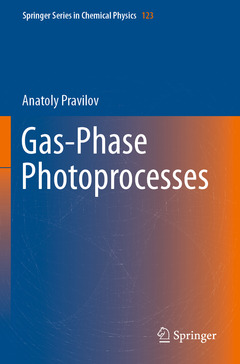Gas-Phase Photoprocesses, 1st ed. 2021 Springer Series in Chemical Physics Series, Vol. 123
Auteur : Pravilov Anatoly

This book provides details of the basic frameworks and characteristics of processes occurring in electronically excited states of small molecules, complexes, and clusters. It discusses the perturbations in electronically excited valence states of molecules induced by intramolecular interaction and intermolecular interactions, which occur in collisions and optically populated, weakly bound complexes. Further, it describes the kinetics and mechanisms of photoprocesses in simple molecules and recombination accompanied by radiation. The book also offers information on general kinetics for gas-phase processes and basic theoretical frameworks for elementary processes.
It features many useful problems, making it a valuable resource for students and researchers in molecular spectroscopy/molecular physics and chemical physics/physical chemistry.
1. Introduction.- 2. General Kinetic Rules for Chemical Reactions, Collisional, and Intramolecular Processes.- 2.1. Rates of Reaction, Collisional, and Spontaneous Processes. Rate Constant. Kinetic Types of Simple Processes.- 2.2. Chemical Equilibrium. Equilibrium Constant.- 2.3. Arrhenius equation.- 2.4. Complex Reactions.- 2.4.1. Consecutive Reactions. Steady-state Method.- Problems.- References.- 3. Theory of Elementary Processes.- 3.1. Cross-sections, Rate Constants, and Probabilities of Elementary processes.- 3.2. The detailed balance principle. Adiabatic approximations. Potential Energy Curves and Surfaces.- 3.3. Descriptions of Collisional Processes using Potential Energy Curves and Surfaces. Intramolecular Vibrational Relaxation in Polyatomic Molecules.- 3.4. Non-adiabatic Transitions. Perturbation theory. Probabilities of Adiabatic and Non-adiabatic Transitions.- 3.5. Intermolecular Interactions. Types of Intermolecular Interactions.- 3.6. Semiempirical Model Potentials.- Problems.- References.- 4. Photoprocesses.- 4.1. Primary and Secondary Gas-Phase Photoprocesses. Quantum Yields of the Gas-Phase Photoprocesses.- 4.2. Optical Transitions. Selection Rules for Optical Transitions. Spin-Orbit Coupling and Spin-Forbidden Radiative Transitions.- 4.3. Absorption. Absorption Band Intensities. Einstein Transition Probabilities. Oscillator Strength. Transition Dipole Moment. Beer-Lambert Law.- 4.4. Franck-Condon Principle for Bound-bound and Bound-free Optical Transitions.- 4.5. Luminescence. Radiative lifetime. The Relationship between Einstein Transition Probabilities and Transition Dipole Moment.- 4.6. Intramolecular Perturbations. Selection Rules and Franck-Condon Principle for Intramolecular Perturbation. Perturbations between Bound States. Abnormally long Radiative Lifetime.- 4.7. Spontaneous Predissociation of Two-, Tri- and Polyatomic Molecules. Classes of Predissociation Processes.- 4.8. Photodecay of Two-, Tri- and Polyatomic Molecules. Long-lived States of Polyatomic Molecules.- References.- 5. Energy Transfer in Collisions.- 5.1. Translational-Translational Energy Transfer (T-T exchange).- 5.2. Rotational-Translational Energy Transfer (R-T exchange).- 5.3. Vibrational Energy Transfer (V-T, V-R,T Processes).- 5.4. Non-adiabatic Coupling and Vibrational Energy Transfer.- 5.5. Collision-Induced Non-Adiabatic Transitions.- 5.6. Collision-Induced Predissociation.- 5.7. Vibrational Relaxation via Several Electronic States.- 5.8. Electronic Deactivation.- Problems.- References.- 6. Weakly-Bound Complexes.- 6.1. Hydrogen- and Halogen-Bond Complexes.- 6.2. Van der Waals Complexes. 6.3. Rare gas-halogen Molecule Clusters.- References.- 7. Termolecular reactions.- 7.1. Termolecular recombination. Mechanism of Termolecular Recombination.- References.- 8. Chemiluminescence.- 8.1. Classes of Chemiluminescence Processes.Gas-P Rate Constants.- 8.2. General Rules of Radiative Recombination.- References.- Solution of Problems.- Index.
Anatoly M. Pravilov is a Professor of physics at Saint Petersburg State University, Russia.
Pravilov teaches kinetics and mechanisms of gas-phase processes and radiometry. The focus of his current research interests lies in gas-phase photochemistry as well as spectroscopy and dynamics in small molecules and weakly bound complexes. He has already published a book on Photoprocesses in Molecular Gases, in 1992 in Russia, a Springer book on Radiometry in Modern Scientific Experiments, in 2011 and a Springer book on The Iodine Molecule: Insights into Intra-and Intermolecular Perturbations in Diatomic Molecules, in 2018.
Summarizes research advances in photoprocesses in the gas phase
Covers intramolecular perturbations in electronically excited states of simple molecules as well as collision-induced processes
Provides basic information on general kinetics for gas-phase processes and theoretical frameworks for elementary processes
Is useful for a range of readers, from students to specialists in the field
Date de parution : 02-2022
Ouvrage de 292 p.
15.5x23.5 cm
Date de parution : 02-2021
Ouvrage de 292 p.
15.5x23.5 cm



